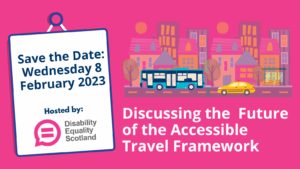Join us on Wednesday 8 February 2023 from 2:00pm – 3:30pm as we host an online discussion about the Accessible Travel Framework. This webinar is an opportunity to discuss what you think the key priorities for Accessible Travel in Scotland should be in the coming years and share your insights about what impactful change you would like to see.
We will hear from key staff at Transport Scotland and Disability Equality Scotland, who will share updates of where we are now and what they feel are the key priorities of the framework from the perspective of their organisations moving forward.
We will then open up into discussion groups which will be facilitated/moderated by staff from Transport Scotland and Disability Equality Scotland. These discussions will be an opportunity to gather feedback on how we measure the success of the Accessible Travel Framework and what we should aim to achieve within the framework’s life span.
Feedback from this webinar will go on to inform the recommendations of the Accessible Travel Framework Evaluation project and report. We’re eager to hear what priorities you have in relation to improving your travel and transport experience and the wider enhancement of accessible travel in Scotland and ensuring that these are prioritised moving forward.
Save 8 February 2023 in your diaries and please come along to share your thoughts and experiences. Further information on how to register for the event will be made available in January 2023.

